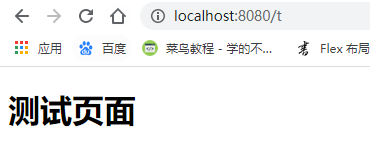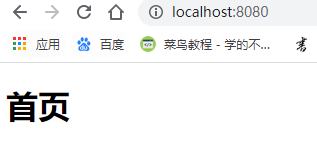9、SpringBoot:MVC自动配置原理
8.1、官网阅读
在进行项目编写前,我们还需要知道一个东西,就是SpringBoot对我们的SpringMVC还做了哪些配置,包括如何扩展,如何定制。
只有把这些都搞清楚了,我们在之后使用才会更加得心应手。途径一:源码分析;途径二:官方文档!
Spring MVC Auto-configuration //SpringBoot为Spring MVC提供了自动配置,它可以很好地与多多数应用程序一起工作 Spring Boot provides auto-configuration for Spring MVC that works well with most applications. //自动配置在Spring默认设置的基础上添加了以下功能: The auto-configuration adds the following features on top of Spring’s defaults: //包含视图解析器 Inclusion of ContentNegotiatingViewResolver and BeanNameViewResolver beans. //支持静态资源文件夹的路径,以及webjars Support for serving static resources, including support for WebJars (covered later in this document)). //自动注册了Converter //转化器,就是我们网页提交数据到后台自动封装成对象的东西,比如把"1"字符串自动转换为int类型 //Formatter:【格式化器,比如页面给我们了一个2019-8-10,它会给我们自动格式化为Date对象】 Automatic registration of Converter, GenericConverter, and Formatter beans. // SpringMVC用来转换Http请求和响应的的,比如我们要把一个User对象转换为JSON字符串,可以去看官网文档解释; Support for HttpMessageConverters (covered later in this document). // 定义错误代码生成规则的 Automatic registration of MessageCodesResolver (covered later in this document). // 首页定制 Static index.html support. // 图标定制 Custom Favicon support (covered later in this document). // 初始化数据绑定器:帮我们把请求数据绑定到JavaBean中! Automatic use of a ConfigurableWebBindingInitializer bean (covered later in this document).
我们来仔细对照,看一下它怎么实现的,它告诉我们SpringBoot已经帮我们自动配置好了SpringMVC,然后自动配置了哪些东西呢?
8.2、ContentNegotiatingViewResolver内容协商视图解析器
自动配置了ViewResolver,就是我们之前学习的SpringMVC视图解析器;
即根据方法的返回值取得视图对象(View),然后由视图对象决定如何渲染(转发,重定向)。
我们去看看这里的源码:我们找到WebMvcAutoConfiguration,然后搜索ContentNegotiatingViewResolver。找到如下方法!
@Bean
@ConditionalOnBean(ViewResolver.class)
@ConditionalOnMissingBean(name = "viewResolver", value = ContentNegotiatingViewResolver.class)
public ContentNegotiatingViewResolver viewResolver(BeanFactory beanFactory) {
ContentNegotiatingViewResolver resolver = new ContentNegotiatingViewResolver();
resolver.setContentNegotiationManager(beanFactory.getBean(ContentNegotiationManager.class));
// ContentNegotiatingViewResolver使用所有其他视图解析器来定位视图,因此它应该具有较高的优先级
resolver.setOrder(Ordered.HIGHEST_PRECEDENCE);
return resolver;
}
我们可以点进这类看看!找到对应的解析视图的代码;
@Nullable // 注解说明:@Nullable 即参数可为null
public View resolveViewName(String viewName, Locale locale) throws Exception {
RequestAttributes attrs = RequestContextHolder.getRequestAttributes();
Assert.state(attrs instanceof ServletRequestAttributes, "No current ServletRequestAttributes");
List<MediaType> requestedMediaTypes = this.getMediaTypes(((ServletRequestAttributes)attrs).getRequest());
if (requestedMediaTypes != null) {
// 获取候选的视图对象
List<View> candidateViews = this.getCandidateViews(viewName, locale, requestedMediaTypes);
// 选择一个最适合的视图对象,然后把这个对象返回
View bestView = this.getBestView(candidateViews, requestedMediaTypes, attrs);
if (bestView != null) {
return bestView;
}
}
// .....
}
我们继续点进去看,他是怎么获得候选的视图的呢?
getCandidateViews中看到他是把所有的视图解析器拿来,进行while循环,挨个解析!
Iterator var5 = this.viewResolvers.iterator();
所以得出结论:ContentNegotiatingViewResolver 这个视图解析器就是用来组合所有的视图解析器的
我们再去研究下他的组合逻辑,看到有个属性viewResolvers,看看它是在哪里进行赋值的!
protected void initServletContext(ServletContext servletContext) {
// 这里它是从beanFactory工具中获取容器中的所有视图解析器
// ViewRescolver.class 把所有的视图解析器来组合的
Collection<ViewResolver> matchingBeans = BeanFactoryUtils.beansOfTypeIncludingAncestors(this.obtainApplicationContext(), ViewResolver.class).values();
ViewResolver viewResolver;
if (this.viewResolvers == null) {
this.viewResolvers = new ArrayList(matchingBeans.size());
}
// ...............
}
既然它是在容器中去找视图解析器,我们是否可以猜想,我们就可以去实现一个视图解析器了呢?
我们可以自己给容器中去添加一个视图解析器;这个类就会帮我们自动的将它组合进来;我们去实现一下
1.我们在我们的主程序中去写一个视图解析器来试试
//扩展SpringMVC
@Configuration
public class MyMvcConfig implements WebMvcConfigurer {
//ViewResolver 实现了视图解析器接口的类,我们就可以把它看作视图解析器
@Bean
public ViewResolver myViewResolver(){
return new MyViewResolver();
}
//自定义了一个自己的视图解析器MyViewResolver
//我们写一个静态内部类,视图解析器就需要实现ViewResolver接口
public static class MyViewResolver implements ViewResolver{
@Override
public View resolveViewName(String s, Locale locale) throws Exception {
return null;
}
}
}
2.怎么看我们自己写的视图解析器有没有起作用呢?
我们给 DispatcherServlet 中的 doDispatch方法 加个断点进行调试一下,因为所有的请求都会走到这个方法中
3.我们启动我们的项目,然后随便访问一个页面,看一下Debug信息;
找到this

找到视图解析器,我们看到我们自己定义的就在这里了;

所以说,我们如果想要使用自己定制化的东西,我们只需要给容器中添加这个组件就好了!剩下的事情SpringBoot就会帮我们做了!
8.3、转换器和格式化器
找到格式化转换器:
@Bean
@Override
public FormattingConversionService mvcConversionService() {
// 拿到配置文件中的格式化规则
WebConversionService conversionService =
new WebConversionService(this.mvcProperties.getDateFormat());
addFormatters(conversionService);
return conversionService;
}
点进去:
public String getDateFormat() {
return this.dateFormat;
}
/**
* Date format to use. For instance, `dd/MM/yyyy`. 默认的
*/
private String dateFormat;
可以看到在我们的Properties文件中,我们可以进行自动配置它!
如果配置了自己的格式化方式,就会注册到Bean中生效,我们可以在配置文件中配置日期格式化的规则:


其余的就不一一举例了,大家可以下去多研究探讨即可!
8.4、修改SpringBoot的默认配置
这么多的自动配置,原理都是一样的,通过这个WebMVC的自动配置原理分析,我们要学会一种学习方式,通过源码研究,得出结论;这个结论一定是属于自己的,而且一通百通。
SpringBoot的底层,大量用到了这些设计细节思想,所以,没事需要多阅读源码!得出结论;
pringBoot在自动配置很多组件的时候,先看容器中有没有用户自己配置的(如果用户自己配置@bean),如果有就用用户配置的,如果没有就用自动配置的;
pringBoot在自动配置很多组件的时候,先看容器中有没有用户自己配置的(如果用户自己配置@bean),如果有就用用户配置的,如果没有就用自动配置的;
扩展使用SpringMVC 官方文档如下:
If you want to keep Spring Boot MVC features and you want to add additional MVC configuration (interceptors, formatters, view controllers, and other features), you can add your own @Configuration class of type WebMvcConfigurer but without @EnableWebMvc. If you wish to provide custom instances of RequestMappingHandlerMapping, RequestMappingHandlerAdapter, or ExceptionHandlerExceptionResolver, you can declare a WebMvcRegistrationsAdapter instance to provide such components.
我们要做的就是编写一个@Configuration注解类,并且类型要为WebMvcConfigurer,还不能标注@EnableWebMvc注解;我们去自己写一个;我们新建一个包叫config,写一个类MyMvcConfig;
//应为类型要求为WebMvcConfigurer,所以我们实现其接口
//可以使用自定义类扩展MVC的功能
@Configuration
public class MyMvcConfig implements WebMvcConfigurer {
//视图跳转
@Override
public void addViewControllers(ViewControllerRegistry registry) {
// 浏览器发送/t , 就会跳转到test页面;
registry.addViewController("/t").setViewName("test");
}
}
我们去浏览器访问一下:

确实也跳转过来了!所以说,我们要扩展SpringMVC,官方就推荐我们这么去使用,即保留SpringBoot所有的自动配置,也能用我们扩展的配置!
我们可以去分析以下原理:
- WebMvcAutoConfiguration 是 SpringMVC的自动配置类,里面有一个类WebMvcAutoconfigurationAdapter
- 这个类上有一个注解,在做其他自动配置时会导入:@Import(EnableWebMvcConfiguration.class)
- 我们点进EnableWebMvcConfiguration这个类看一下,它继承了一个父类:DelegatingWebMvcConfiguration
@Configuration
public class DelegatingWebMvcConfiguration extends WebMvcConfigurationSupport {
private final WebMvcConfigurerComposite configurers = new WebMvcConfigurerComposite();
// 从容器中获取所有的webmvcConfigurer
@Autowired(
required = false
)
public void setConfigurers(List<WebMvcConfigurer> configurers) {
if (!CollectionUtils.isEmpty(configurers)) {
this.configurers.addWebMvcConfigurers(configurers);
}
}
//...
}
- 我们可以在这个类中去寻找以下我们刚才设置的viewController当做参考,发现它调用了一个:
protected void addViewControllers(ViewControllerRegistry registry) {
this.configurers.addViewControllers(registry);
}
- 我们点击去看一下
public void addViewControllers(ViewControllerRegistry registry) {
Iterator var2 = this.delegates.iterator();
while(var2.hasNext()) {
// 将所有的WebMvcConfigurer相关配置来一起调用!包括我们自己配置的和Spring给我们配置的
WebMvcConfigurer delegate = (WebMvcConfigurer)var2.next();
delegate.addViewControllers(registry);
}
}
所以得出结论:所有的WebMvcConfiguration都会被作用,不止Spring自己的配置类,我们自己的配置类当然也会被调用;
8.5、全面接管SpringMVC
官方文档:
If you want to take complete control of Spring MVC you can add your own @Configuration annotated with @EnableWebMvc.
全面接管:SpringBoot对SpringMVC的自动配置不需要了,所有都是我们自己去配置!只需要在我们的配置类中@EnableWebMvc
我们看下如果我们全面接管了SpringMVC了,我们之前SpringBoot给我们配置的静态资源映射一定会无效,我们可以去测试一下;
不加注解之前,访问首页:

给配置类加上注解:@EnableWebMvc

我们发现所有的SpringMVC自动配置都失效了!回归到了最初的样子;
当然,我们开发中,不推荐使用全面接管SpringMVC
思考问题?为什么加了一个注解,自动配置就失效了!我们看下源码:
- 这里发现它是导入了一个类,我们可以继续进去
@Import({DelegatingWebMvcConfiguration.class})
public @interface EnableWebMvc {
}
- 它继承了一个父类 WebMvcConfigurationSupport
public class DelegatingWebMvcConfiguration extends WebMvcConfigurationSupport {
// ......
}
- 我们来回顾一下Webmvc自动配置类
@Configuration(proxyBeanMethods = false)
@ConditionalOnWebApplication(type = Type.SERVLET)
@ConditionalOnClass({ Servlet.class, DispatcherServlet.class, WebMvcConfigurer.class })
// 这个注解的意思就是:容器中没有这个组件的时候,这个自动配置类才生效
@ConditionalOnMissingBean(WebMvcConfigurationSupport.class)
@AutoConfigureOrder(Ordered.HIGHEST_PRECEDENCE + 10)
@AutoConfigureAfter({ DispatcherServletAutoConfiguration.class, TaskExecutionAutoConfiguration.class,
ValidationAutoConfiguration.class })
public class WebMvcAutoConfiguration {
}
总结一句话:@EnableWebMvc将WebMvcConfigurationSupport组件导入进来了;
而导入的WebMvcConfigurationSupport只是SpringMVC最基本的功能!
在SpringBoot中会有非常多的扩展配置,只要看见了这个,我们就应该多留心注意~
- SpringBoot自动配置原理
- SpringBoot自动配置注解原理解析
- SpringBoot学习笔记(3) Spring Boot 运行原理,自动配置
- SpringBoot的自动配置原理过程解析
- spring boot 中mvc自动配置原理
- springboot:自动配置原理
- SpringBoot的自动配置原理
- SpringBoot的自动配置原理
- SpringBoot启动及自动配置原理(注解)分析
- SpringBoot学习笔记(三) SpringBoot 自动配置原理
- Spring Boot 运行原理 - 查看Spring Boot自动配置项
- SpringBoot自动配置原理
- springboot自动配置原理
- SpringBoot自动配置原理
- SpringBoot自动配置原理
- SpringBoot学习笔记(一)SpringBoot2 自动配置原理
- SpringBoot 自动配置原理
- springboot自动配置原理
- spring boot实战(第十三篇)自动配置原理分析
- SpringBoot-03自动配置原理
